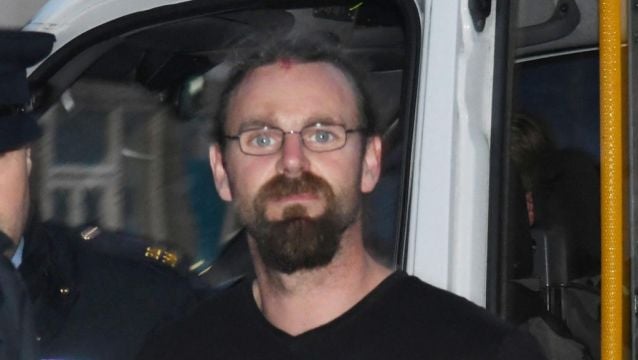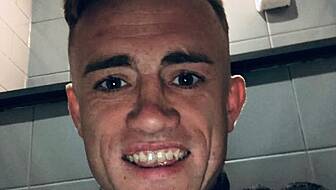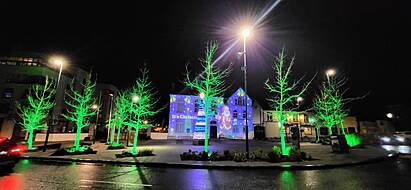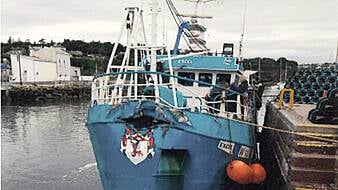Stephen Silver, who is on trial accused of murdering Garda Colm Horkan with his own gun, engaged in “normal chit-chat” with a number of workmen he met over breakfast on the morning the garda was shot and killed, the Central Criminal Court has heard.
Witness Seamus Horgan said he and two colleagues encountered Mr Silver while they were staying in a hotel in Dublin and over breakfast on the morning of June 17th, 2020, he struck up a “normal conversation” with them about sport, politics and work.
The jury also heard on Tuesday that Gda Horkan previously escorted Mr Silver to a psychiatric unit when gardaí were called to the Silver family home almost 20 years ago.
Retired Garda Sergeant Thomas O’Connor told the jury that gardaí were called to the home the accused shared with his family on October 29th, 2003, and Gda Horkan and his colleague travelled with Mr Silver to the psychiatric unit at Roscommon General Hospital as part of a garda escort.
Mr Silver (46), a motorbike mechanic from Aughavard, Foxford, Co Mayo, has pleaded not guilty to the murder of Garda Colm Horkan (49) knowing or being reckless as to whether he was a member of An Garda Síochána acting in accordance with his duty at Castlerea, Co Roscommon on June 17th, 2020. He has pleaded guilty to manslaughter.
Mr Horgan told Michael Delaney, prosecuting, he was carrying out contract work on behalf of the ESB in Dublin and was staying in the Carlton Hotel in Tyrrelstown with two colleagues.
He said on the morning of June 17th, 2020, they chatted to the accused, Stephen Silver, who was not known to them at the time, and engaged in “normal chit-chat”.
He said they had noticed Mr Silver with a female companion in the restaurant the night before but did not speak to them. He later encountered Mr Silver in the hallway upstairs when the accused was looking for his room and Mr Horgan pointed him in the direction of what he thought was his room number.
“It was a normal passing conversation,” Mr Horgan said.
The witness said he and his colleagues next encountered the man at breakfast the following morning when they all took part in a “general conversation”.
“He mentioned Roscommon, he mentioned something about working in England. He was reading the paper. It was just normal chit-chat,” Mr Horgan said.
Asked by Mr Delaney what his recollections were of how the man interacted with him and his colleagues, Mr Horgan said: “I found it a normal conversation, a normal interaction with a stranger at breakfast.”
'Small confrontation'
Mr Horgan’s colleague, Luke Mollahan told prosecuting counsel James Dwyer he noticed the man in the restaurant the night before. He said the man had a goatee, sideburns and long hair tied back in a man bun.
Mr Mollahan said the man was talking to a female companion. He said he could hear the accused asking what was wrong and this was followed by a “small confrontation with a barman”.
“I knew there was some commotion, but I didn’t know what it was about. The man was somewhat aggravated,” the witness told prosecution counsel.
He said at breakfast the following morning, he and his colleagues spoke to Mr Silver about the weather and work.
He said the conversation then moved on to politics and stuff he had seen in the paper. After the conversation dropped, Mr Silver reinitiated it and talked about where they were each from, the witness added.
His workmates told the man Mr Mollahan was from Roscommon and they talked about "my hometown, his hometown".
"He mentioned he had played football and rugby back home,” the witness said, adding Mr Silver mentioned he had been in Tyrrelstown the previous day and there had been dead rats on the street.
On Tuesday morning, Forensic Scientist Dr Sibeal Waldron of Forensic Science Ireland outlined a number of rips and tears on Gda Horkan’s clothing. She told the court that due to heavy-bloodstaining and medical intervention, she could not say when this damage occurred or to what extent it may have been as a result of a struggle.
Dr Waldron said Garda Horkan’s Tommy Hilfiger jacket contained ten holes, while the shirt he was wearing underneath contained only seven, indicating that his jacket was out of line and raised up off the shirt.
In response to a question from Ms Justice Tara Burns, Dr Waldron said the holes could be bullet holes but said firearms residue would be needed to confirm that.
In her direct evidence to the court on Tuesday afternoon, State Pathologist Dr Linda Mulligan said the location of the bullet holes in the jacket suggested “it may have been pulled or disturbed during the altercation”.
Retired Garda Sergeant Thomas O’Connor told the court he was called to the Silver family home in the early hours of October 29th, 2003, in relation to an incident there.
He said he was assisted by a number of his colleagues, including Gda Colm Horkan who was due to start work that morning as part of the early 6am shift.
The retired Sgt told Mr Delaney he was also joined at the property by a local GP who had been called out by the family some days earlier.
He said it was deemed appropriate that Mr Silver by brought to the local psychiatric unit attached to Roscommon General Hospital and Gda Horkan along with one of his colleagues, escorted the accused to the facility.
Catastrophic injuries
In her evidence to Mr Delaney, Dr Mulligan detailed numerous gunshot wounds sustained by Gda Horkan. These included wounds to his left shoulder, neck, abdomen, armpit, chest, hip and both his left and right thigh.
She said the garda appeared to have been shot 11 times from multiple angles with a cluster of gunshot wounds to the left shoulder area.
One of the gunshot wounds displayed soot and powder tattooing in keeping with a close-range injury, she said, while the majority of the other wounds were consistent with an intermediate range of between one foot and one metre.
The State pathologist said Garda Horkan’s injuries included a torn aorta, a rupture to the right chamber of the heart, a torn right artery, damage to the abdomen, extensive damage to the bowel and lacerations to the liver and kidney.
Dr Mulligan told these were catastrophic injuries and were non-survivable, particularly the injury to the aorta and the heart.
Garda Horkan’s cause of death was multiple gunshot wounds with no contributing factors, she said.
Before Dr Mulligan gave evidence, defence counsel Dominic McGinn made a formal admission on behalf of Mr Silver stating that an injury to Garda Horkan’s left eye and temple, which the State Pathologist would give evidence of, was caused by the accused as a result of a blow from a gun.
Superintendent Goretti Sheridan gave evidence to Mr Delaney that she was the District Officer in Castlerea in June 2020.
She said at that time Gda Horkan was trained and certified to carry firearms and she formally requested he work as a detective on a temporary basis.
She said he was not appointed officially to the role but as a result of a shortage of detectives in the district and because he was trained in firearms, Gda Horkan was appointed temporarily, subject to review, for the duration of the Covid pandemic.
She agreed with Mr Delaney that as a member acting in the duty of a detective he was authorised to operate in plain clothes and carry a firearm.
Under cross-examination, she confirmed to Mr McGinn that the formal term to someone appointed to the role temporarily is a Detective Aid.
The Superintendent said this was not an uncommon thing to happen and said Gda Horkan was someone who would have the capacity to work as a detective.
Asked by Mr McGinn if ordinarily detectives would work in pairs, Superintendent Sheridan said “in an ideal world” this would be the case, but it was not something that was “set in stone” and detectives would often work independently.
Asked by Mr McGinn if there was any particular reason why Gda Horkan would have a firearm on a weekday evening in Castlerea in June, she said for someone in his position it was “routine”.

At the opening of the trial, Mr McGinn told the jury that there was no issue with the cause of death in this case, as it was accepted that Gda Horkan tragically died as a result of being shot a number of times.
Mr McGinn said that the accused’s responsibility is accepted, as Mr Silver admits shooting and killing Gda Horkan.
“The main issue is Mr Silver’s state of mind at the time,” said Mr McGinn.
The trial continues on Wednesday before Ms Justice Tara Burns and the jury of seven men and five women.







